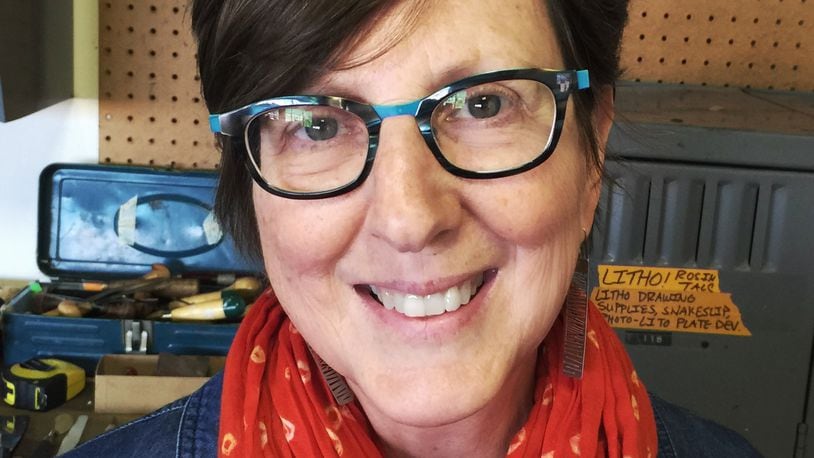As an artist, Jacobs continues to evolve. Besides a painter, she’s a printmaker. Jacobs says she got into printmaking to inform her painting, and that she discovered that her painting also informs her printmaking. “It’s come full circle,” she says.
Jacobs was a graphic designer at LexisNexis, then decided to devote more time to her art. An important dimension for her is working within a community of artists. She and her husband are art collectors; including the works of other artists in her home is important to her.
“Artists invest a lot of themselves in their work," Jacobs said. "It’s not like it’s your kids, but more like a pet. There’s a bond, and it means a lot because they’ve put a lot into it."
Jacobs has been working on the painting for the library.
“Thinking about it makes me sweat,” she said. “It’s going to be up for a long time. I really want it to be good. I want it to have longevity.”
Her work combines the organic and non-organic, and explores the tension between clarity and ambiguity, with some obvious meaning and some submerged below the surface.
We recently caught up with Gretchen Jacobs, our Daytonian of the Week.
For an artist, what is the importance of being part of a community of artists? Well, not all artists feel that this is important, some really prefer to work alone. However, I can tell you what I get out of it. It's the tradition that art is not created in a vacuum. It's sharing experiences, struggles, ideas, concepts, philosophies and just the everyday stuff of making work that is important to artists. It's important because it's helpful and insightful -- it's helpful information that I didn't see or think of, and insightful for the same reasons. There is an objectivity to the sharing, nobody is telling you what to do or how to do it, nor are they saying it's good or bad (well, most don't anyway).
It’s experiencing and being with other artists who share the same sensibility as you, and receiving feedback or constructive critisim can help move my work in a clearer direction. I don’t think anyone is ever “beyond” feedback or criticism; you can, of course, be selective in who you ask and what you digest, and sometimes it creates differences in opinion, and the artists I want to hang out with are tolerant and OK with different opinions.
Tell us about The Dayton Printmakers Cooperative. What is it and how did you get involved? The Dayton Printmakers Cooperative is a nonprofit alliance of printmakers and artists. The Cooperative provides a studio environment for artists to pursue their work and broaden their knowledge of the printmaking media. The printmakers participate in workshops, portfolio exchanges and group exhibits, as well as participate in exchange collaborations with national and international studios.
Our primary mission is to provide our members with the facility, the opportunity and the stimulus to create while increasing awareness about contemporary printmaking throughout our community through sponsored programs, exhibitions and workshops.
The Co-Op was founded in 1983 to provide printmaking facilities to all qualified Miami Valley artists. Along with the active members' use of the space and presses, the Print Co-op invites other visual artists’ participation.
The Print Co-Op is member supported through monthly dues as well as special Summer Membership rates including workshops, student and recent graduate rates, temporary monthly artists rates and soon to be announced open studio hours. It's located at 913 N. Keowee St., Dayton. If you have questions, email us at info@thedaytonprintmakers.com
How can artists use the co-op? There are open studios where artists can pay a fee to use the co-op; however, there needs to be a basic understanding of the processes of printmaking and some prior experience. We offer workshops in the summer.
This summer, for example, we're offering printmaking workshops covering Stone Lithography, Monoprint/Drypoint, Woodcut & Bookbinding, Etching/Intaglio, and Screen Printing. Schedule soon as workshops fill up quickly. The workshop fee for non-members is $110, which includes the cost of some materials.
We're also bringing back our popular Summer Membership, $250 for four months for full use of studio and two free workshops. Additional workshops are $110.
What role do you think artists play in any community? I'm not sure how to answer this question, but I'll give it a whirl: Most artists, in general terms, pay attention to, are sensitive to, responsive to, have strong perceptions/opinions about the world in which we live. There is a very strong drive to express these things and put them out there, so to speak, so others can possibly experience, connect or understand what they are experiencing. Those who are not artistic may or may not appreciate the "interpretation" or the "voice" of the artist. I guess in a perfect scenario, artists express or reveal things in a visual way that maybe non-artists cannot seem to do but may appreciate.
How can the public support the work of local artists? Buy the work of local artists. You can find out who they are through the universities and colleges. Wright State University, the University of Dayton and Sinclair Community College all have art departments, and those instructors are working artists who regularly create work.
DVAC is another great place to start. Attend openings, art auctions, etc. A new gallery on Front Street called Dutoit Gallery is a cooperative gallery which I am part of. There will be openings every month of new work. More than 25 artists were chosen and asked to participate at Dutoit. This is a strong and active group of artists, ranging from emerging artists to mid-career and beyond. All of the artists were “invited” to join, so a certain level of accomplishment, work ethic and respectability played into that decision. There is an opening every month, on First Friday.
About the Author
